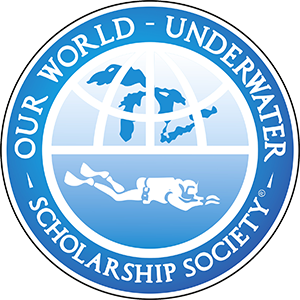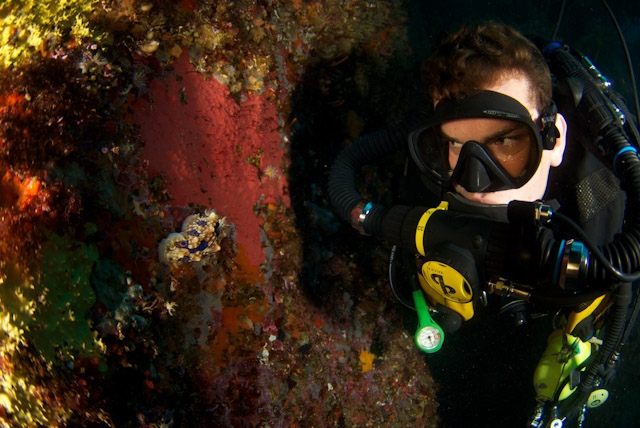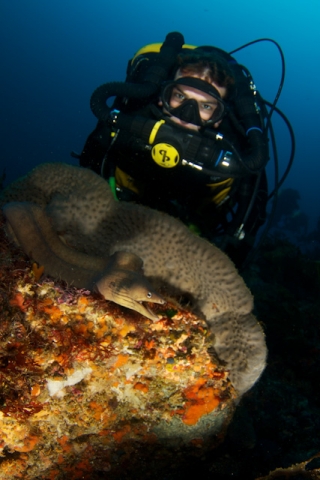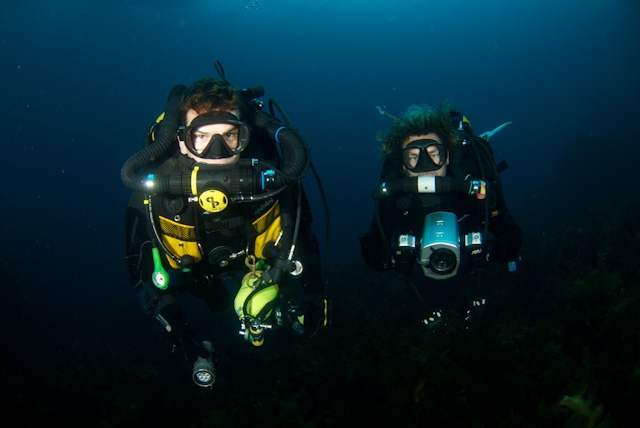The multi-coloured wall of the Northern archway moves fluidly with the current as we silently glide past. Moving closer, a cornucopia of encrusting organisms become visible, stipes of kelp brush past my face and I move in for a look at an intricately decorated nudibranch making it’s way across a bright red sponge. Suddenly a shadow passes across my field of view. Gazing towards the surface I see the white underside of a large stingray only meters away, lazily gliding over us, completely unperturbed by our presence. I smile and turn to my left, signaling the OK to Steve Lindfield. Just beyond, our rebreather instructor Pete Mesley gazes ever watchful at his group of divers, ready to spring a surprise drill on any one of us.
A small nudibranch moves slowly across the wall we are gliding along
The story of how I ended up on a rebreather in the Poor Knight Islands, New Zealand begins back in Birmingham, England in October, where I found myself sitting at the EuroTek 2010 banquet next to Dr. Simon Mitchell. Throughout the dinner we discussed the scholarship, interests and future goals. The subject of rebreathers and New Zealand diving cropped up, and I asked Simon if he knew of anyone who might be interested in hosting me for a project back home. Simon said he had a good friend there, Pete Mesley, and he would be more than happy to get I touch with him on my behalf. My gratitude to Simon was fuelled by my knowledge of Pete’s reputation as one of the best diving instructors out there.
A week later Pete and I made contact. He already knew of the scholarship as he was one of the photographers alongside Leigh Bishop on the National Geographic Britannic expedition last year on which the 2009 European Scholar Filip Wolski was part of. He was very keen to help out and said we should try getting me on his upcoming Closed Circuit Rebreather part 1 course.
This was the beginning of what has been one of the most challenging, exciting, and inspiring scholarship experiences I have had the fortune to undertake. The first hurdle was to find a rebreather in which I could use during the course. I emailed Simon who very kindly said I would be more than welcome to borrow his Evolution + for the course.
Swelling with excitement due to the fact I would be diving Dr. Simon Mitchell’s rebreather under the instruction of one the best rebreather instructors in the world and to top it all off our last two days diving were to be in the Poor Knight Islands! Temperate diving at it’s best!
Arriving in Auckland on a Sunday evening I turned up at Pete’s where he and his family welcomed me with open arms in a very busy holiday time, which was greatly appreciated. On Monday we were joined by Mike Jones, the second student on the course, with a strong cup of coffee on all sides we go stuck into the theory, covering everything from the early history of rebreathers, functioning components, human physiology and everything in between.
With the dry portion of the course out of the way we excitedly donned our units and had the chance to try them out in the local pool where we spent time running through basic drills before the initial open water dives and just getting used to the feel of the units underwater.
Over the next three days we undertook the initial open water dives at lake Pupuke, located on Auckland’s North Shore. During this period we were joined by 2008 Australasian Scholar Steve Lindfield. Steve had completed his CCR level 1 course on during his scholarship year and had come over from Australia to join us for some dives in the Poor Knight Islands on his own Inspiration rebreather.
Descending down to various depths we would swim around undertaking a broad range of shutdown drills and problem solving checks. Pete would increase the difficultly of our tasks, first completing them under his prompts, later a slate with ALARM written across it would be thrust before your eyes, then using a number of different slates with potential error messages, Pete would choose one that may arise during a dive, such as cell warning, high or low O2, scrubber warning… the list goes on. We would then need to run through a series of steps that might help us determine the problem and fix it. All of the drills needed to be completed while maintaining your buoyancy, which was initially something I really struggled with. The lake bed was covered in a fine powder like silt meters deep, the slightest touch or overly strong fin kick would have a huge cloud of silt billow up clouding destroying all visibility which made for the perfect training environment. These factors combined forced us to be constantly diligent of our surroundings.
I quickly found that rebreather diving requires lateral thinking and a cool head. You’re required to remain calm and collected whilst being task loaded in a high stress situation, methodically running through checklist to diagnose any problem that might arise and then put into action a series of steps that can solve said problem. This is especially important in the more advanced levels of rebreather diving. If something was to go wrong the instinct of dashing to the surface simply isn’t an option, the situation must be resolved whilst you are down underwater. I found that I was really pushed in this respect; all of a sudden I was a novice once again. New equipment, a new set of rules for buoyancy, new drills, and the room for error is so much smaller. The course was the hardest that I have ever completed in my dive career thus far, it was also the most satisfying, educational, and inspiring.
After completing the lake portion of the course we made our way up to the sleepy town of Tutukaka. The Poor Knights Islands lie 23 kilometers off the coast and are reached everyday by boat charter. We were diving with Yukon Charters; owned and operated by two of the most down to earth people I have had the fortune to meet, Noel Erickson and Jo Thomson who are good friends of Pete. We were staying at the house of another friend of Pete’s, looking over the harbour. The view was breathtaking and certainly didn’t do any good for my want to get out and dive! There was a great little team up with us, with seven rebreather divers on the charter we were the dominating force!
When getting up close to marine life rebreathers really come into their own.
The first dive had us dropping down to around 25m. Ctenophores filled the upper surface of the water sometimes so thick they obstructed your view of the bottom. Upon passing through them the visibility was fantastic, having a clear visual reference in contrast to the constant murk of the lake made such a difference, I also found at the deeper depths everything on the rebreather just settled down. My buoyancy much easier to control, I was instantly more relaxed.
Steve and myself. Rebreather scholars!
We completed four dives out at the Poor Knights, all of which were dives to remember. Of particular mention was the first dive in which were visited by a rare and spectacular creature, the Sunfish! It was the first Sunfish Steve and I had ever seen, and I’m positive we would never have been fortunate enough to be visited by it had we been bubbling away on open-circuit. I think very fondly of Steve’s excited “Oh my god!” as the sunfish appeared into view, he came within meters of the rebreather group and fellow rebreather diver Ian Skipworth took some footage that he has kindly given me permission to show. In the midst of being distracted by the sunfish the now familiar red letters spelling ALARM! suddenly obscured my vision. Quickly followed by a high O2 warning slate. I took a second to pause and collect what I needed to do in my mind then ran through the necessary checks. This scenario illustrated perfectly to me how I must constantly be aware of what is happening with my unit. You need half your brain constantly monitoring your rebreather while the other one can look at all the pretty sunfish swimming by.
Ascending from the final dive Pete congratulated all his students on becoming newly certified CCR level 1 divers! I feel Pete has really set me up to become a strong rebreather diver in the future, I have a new found respect for the amazing piece of equipment that rebreathers are and what it means to be a user of one. I can’t thank Pete and Simon enough for all their help and support, as well as Noel and Jo at Yukon, Steve, and all the others who joined us up at the Poor Knights. Thank you all.
All the images above were photographed by Pete Mesley (www.petemesley.com)

















